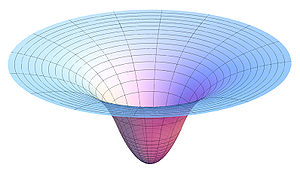Force field (physics)

In physics, a force field is a vector field that describes a non-contact force acting on a particle at various positions in space. Specifically, a force field is a vector field , where is the force that a particle would feel if it were at the point .[1]
Examples[]
- Gravity is the force of attraction between two objects. A gravitational force field models this influence that a massive body (or more generally, any quantity of energy) extends into the space around itself.[2] In Newtonian gravity, a particle of mass M creates a gravitational field , where the radial unit vector points away from the particle. The gravitational force experienced by a particle of light mass m, close to the surface of Earth is given by , where g is the standard gravity.[3][4]
- An electric field is a vector field. It exerts a force on a point charge q given by .[5]
Work[]
Work is dependent on the displacement as well as the force acting on an object. As a particle moves through a force field along a path C, the work done by the force is a line integral
This value is independent of the velocity/momentum that the particle travels along the path.
Conservative force field[]
For a conservative force field, it is also independent of the path itself, depending only on the starting and ending points. Therefore, the work for an object travelling in a closed path is zero, since its starting and ending points are the same:
If the field is conservative, the work done can be more easily evaluated by realizing that a conservative vector field can be written as the gradient of some scalar potential function:
The work done is then simply the difference in the value of this potential in the starting and end points of the path. If these points are given by x = a and x = b, respectively:
See also[]
References[]
- ^ Mathematical methods in chemical engineering, by V. G. Jenson and G. V. Jeffreys, p211
- ^ Geroch, Robert (1981). General relativity from A to B. University of Chicago Press. p. 181. ISBN 0-226-28864-1., Chapter 7, page 181
- ^ Vector calculus, by Marsden and Tromba, p288
- ^ Engineering mechanics, by Kumar, p104
- ^ Calculus: Early Transcendental Functions, by Larson, Hostetler, Edwards, p1055
External links[]
| Wikiquote has quotations related to: Force field (physics) |
- Conservative and non-conservative force-fields, Classical Mechanics, University of Texas at Austin
- Force
- Classical mechanics stubs
- Electromagnetism stubs











